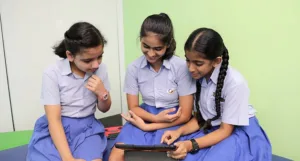We all know that every child is unique. They have a unique set of skills, strengths, and weaknesses depending on their personalities.
Similarly, they have unique preferences when it comes to participating in play activities and learning or retaining information. These preferences are the learning styles that help children comprehend, process, and store information they gather every day.
There are four common learning styles, namely, visual, auditory, verbal, and physical or kinesthetic. These learning styles are used by children to understand the information they receive and interpret.
Some children prefer one learning style, while others may use multiple learning styles. It is, therefore, important for schools to employ all the learning styles while imparting knowledge so that every child understands the concepts to the best of their ability.
Let’s explore these learning styles that are followed by primary school in Singapore and how they are used to improve students’ performances.
1. Visual Learning
Children who use their visual memory to retain information are visual learners. They prefer the visual or spatial type of learning. They find it easier to understand concepts when explained with the help of diagrams, pictures, charts, videos, etc.
These children are observant and have an impressive attention span which helps them understand and imbibe information faster.
The best way to capture their attention is by using color-coding technology, images, diagrams, and projectors.
2. Physical Learning
Children who prefer hands-on learning or interactive learning are physical learners. They find it difficult to listen to lectures or sit still in the class and prefer movement.
They are often restless by nature and prefer tangible objects, such as props and models, which they can touch and feel to understand the intricacies of a topic.
When sharing information using the physical or kinesthetic learning style, the teachers make use of interactive models and props. They encourage movement in between lessons and ensure decluttered desks that help these students concentrate better.
3. Auditory Learning
Children who grasp and interpret concepts by hearing or saying them aloud prefer the auditory learning style.
Auditory learners are keen listeners, who can notice every change in voice or tone, quickly. They eagerly participate in debates and group discussions or exchange views on different topics.
These children can get easily distracted and hence need to be drawn into the study session through discussions and debates. The teachers make use of voice modulations and changing pitches while reading study materials or narrating stories.
Discussions, debates, or story narrations are interesting activities for kids that help improve their concentration and cognitive skills, too.
4. Verbal Learning
The verbal learning style consists of reading and writing a study material to understand it better.
Verbal learners prefer reading the written material or writing it themselves. These learners have a great vocabulary and use tongue twisters, acronyms, etc, to comprehend and retain information.
Teachers at the best private schools in Singapore make use of songs, rhymes, and phrases to help explain linguistic concepts to their school students. They also encourage students to play word games, such as crossword puzzles, as well as write down their ideas or express them, verbally.
5. Logical Learning
The logical or mathematical learning style uses the process of categorizing information into groups for better understanding.
Logical learners are quick at recognizing patterns and sequences, and also grasping equations. They prefer things in a proper structure and find mathematics interesting and intriguing.
To help logical learners comprehend concepts, teachers often infuse statistics into subjects to make them as interesting as mathematics.
6. Linguistic Learning
Linguistic learning is a combination of verbal and auditory learning. Linguistic learners absorb information by reading, writing, and verbalizing the material. Linguistic learners also prefer listening to understand and retain information.
To help linguistic learners, teachers read aloud the lessons and encourage students to read, too. They also give students assignments and projects, which help them memorize the concepts perfectly.
It’s important to avoid using diagrams and pictures in the notes or using a monotone while reading. Reading in different pitches and tones makes the lessons fascinating for the students.
7. Musical Learning
Some students prefer listening to music while studying. Although for many, this might seem counterproductive, for musical learners, this proves to be helpful. They learn and understand better in the company of rhythm and beats.
Often, these learners grow up to be singers, musicians, and instrumentalists. Some students also use auditory learning along with musical learning to grasp concepts better.
The easiest way to help musical learners is by playing soft background music when they are learning or encouraging them to listen to podcasts. Podcasts are also effective in inspiring and motivating students to put in their best.
8. Naturalist Learning
Some students enjoy the learning process better when conducted outdoors, amidst nature. They like observing the world around them and comprehend better through practical experiences.
These students are similar to physical or kinesthetic learners as they prefer tactile sensations as these help them retain information better.
Teachers often take their students on field trips or conduct lessons outdoors. This enlivens the atmosphere for students and results in better understanding and recall.
9. Social Learning
Social or interpersonal learning consists of learning in a group.
Social learners are sensitive to others’ feelings, display leadership qualities, and have good communication skills that make them a favorite among their peers. Social learning also takes place alongside other learning styles.
To encourage social learners, teachers conduct group activities, group projects, and role-playing. These activities offer a fantastic opportunity for social learners to not just develop their innate social qualities but also understand and retain information quicker.
Also Read: 10 Life Skills to Teach Your Child at An Early Age
10. Solitary Learning
Solitary or intrapersonal learning happens when students prefer learning on their own. They are independent learners, who do not appreciate interference by other children and feel comfortable in their personal space. They are often the quietest in class and prefer solitude.
A solitary learning style could also take place alongside other learning styles. To help such children study better, teachers offer them a designated area to work by themselves and check on them every once in a while.
Conclusion
It is very important to understand that every child is unique and has his or her own needs and preferences when it comes to learning. Therefore, it’s crucial to not label children but to encourage them to learn in a way that suits them best.
Understanding their learning styles and the subjects that they find interesting will help children thrive and grow up to be successful individuals.

































